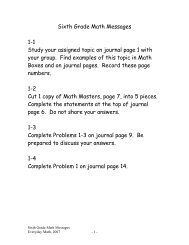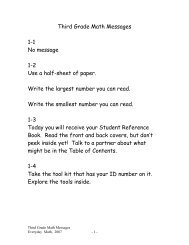Fifth Grade Math Messages - Everyday School Supply
Fifth Grade Math Messages - Everyday School Supply
Fifth Grade Math Messages - Everyday School Supply
Create successful ePaper yourself
Turn your PDF publications into a flip-book with our unique Google optimized e-Paper software.
FIFTH GRADE MATH MESSAGES<br />
1-1<br />
Look through your journal for things that may be<br />
different from your fourth grade journal. Read<br />
“Welcome to <strong>Fifth</strong> <strong>Grade</strong> <strong>Everyday</strong> <strong>Math</strong>ematics”<br />
on page 1. Underline any words or terms that you<br />
do not know or that you think are interesting.<br />
1-2<br />
Arrange 12 counters into as many different<br />
rectangular arrays as you can. Then choose and<br />
draw one of the arrays.<br />
1-3<br />
Solve Problem 1 at the top of journal page 10.<br />
1-4<br />
Which of the following numbers are factors of 36?<br />
1, 2, 3, 4, 5, 6, 7, 8, 9, and 10?<br />
1-5<br />
Solve Problems 1 and 2 at the top of journal page<br />
13.<br />
<strong>Fifth</strong> <strong>Grade</strong> <strong>Math</strong> <strong>Messages</strong><br />
<strong>Everyday</strong> <strong>Math</strong>, 2007 - 1 -
1-6<br />
Draw all possible rectangular arrays for these<br />
numbers: 2, 4, 5, 10, 11, and 16.<br />
1-7<br />
Use counters to try and make a rectangular array<br />
with an equal number of rows and columns for each<br />
number: 14, 16, and 18.<br />
Which numbers make this kind of array?<br />
1-8<br />
Find the numbers that make these statements<br />
true.<br />
___+___ =4<br />
___ 2 = 81<br />
1-9<br />
8 + 8 and 4 * 4 are two names for the number 16.<br />
On a quarter-sheet of paper, write at least five<br />
other names for 16.<br />
<strong>Fifth</strong> <strong>Grade</strong> <strong>Math</strong> <strong>Messages</strong><br />
<strong>Everyday</strong> <strong>Math</strong>, 2007 - 2 -
1-10<br />
Complete the Self Assessment (Assessment<br />
Handbook, p. 154).<br />
2-1<br />
If you were measuring the length of a school bus,<br />
would you use inches, feet, or yards? Why?<br />
Use the unit of measure you chose to estimate the<br />
length of a school bus.<br />
2-2<br />
Use the information on Student Reference Book,<br />
pages 28-30 to solve the Check Your<br />
Understanding Problems on the bottom of page 30.<br />
2-3<br />
Solve each problem.<br />
81 - 47 = ?<br />
8.1 – 4.7 = ?<br />
Describe how the two problems are alike and<br />
different.<br />
<strong>Fifth</strong> <strong>Grade</strong> <strong>Math</strong> <strong>Messages</strong><br />
<strong>Everyday</strong> <strong>Math</strong>, 2007 - 3 -
2-4<br />
Niko has $8.00. Does he have enough money to buy<br />
3 fancy pencils for $1.98 each and an eraser for<br />
$1.73? What is the cost of 3 pencils and 1 eraser?<br />
2-5<br />
Cut out the Grab-it Gauge on Activity Sheet 2.<br />
2-6<br />
Complete journal page 43.<br />
2-7<br />
Use the numbers 10, 6, 9, 8, and 5 to make<br />
expressions that are equivalent names for 1, 10,<br />
and 100. Use addition, subtraction, multiplication,<br />
division, or exponents, and try to use all 5 numbers.<br />
Record your expressions on the class name<br />
collection box for that number.<br />
<strong>Fifth</strong> <strong>Grade</strong> <strong>Math</strong> <strong>Messages</strong><br />
<strong>Everyday</strong> <strong>Math</strong>, 2007 - 4 -
2-8<br />
Estimate the solution to this problem. Write a<br />
number sentence showing how you found your<br />
estimate.<br />
3.7 * 6.2 =<br />
2-9<br />
Study the problems in Column A on journal page 54.<br />
Then use lattice multiplication to solve the<br />
problems in Column B.<br />
2-10<br />
Explain the strategy you would use to find the<br />
number of minutes in one year.<br />
2-11<br />
Complete the Self Assessment (Assessment<br />
Handbook, p. 158).<br />
3-1<br />
Use information from the Student Reference<br />
Book, page 369, to answer the following questions:<br />
What is the U.S. Census, and why is it important?<br />
<strong>Fifth</strong> <strong>Grade</strong> <strong>Math</strong> <strong>Messages</strong><br />
<strong>Everyday</strong> <strong>Math</strong>, 2007 - 5 -
3-2<br />
What is the largest number in the table on page<br />
371 of the Student Reference Book?<br />
3-3<br />
How might you use this figure to prove that the<br />
measure of each angle of a square is 90°? Be<br />
prepared to explain your answer.<br />
3-4<br />
Use only the information given on journal page 68<br />
to complete Problems 1 and 2.<br />
3-5<br />
Draw the largest and the smallest circle you can<br />
draw with your compass. What is the radius of the<br />
largest circle?<br />
<strong>Fifth</strong> <strong>Grade</strong> <strong>Math</strong> <strong>Messages</strong><br />
<strong>Everyday</strong> <strong>Math</strong>, 2007 - 6 -
3-6<br />
Use only the information given on the page and<br />
complete the problems on page 75 in your journal.<br />
3-7<br />
Solve the problem on journal page 80.<br />
3-8<br />
Follow the directions on <strong>Math</strong> Masters, page 89.<br />
3-9<br />
Use a straightedge to draw a big triangle on a<br />
sheet of paper. Measure its angles and find the<br />
sum. Record the sum on the class line plot.<br />
3-10<br />
Answer the three questions on the top of journal<br />
page 92.<br />
3-11<br />
Complete the Self Assessment (Assessment<br />
Handbook, page 164).<br />
<strong>Fifth</strong> <strong>Grade</strong> <strong>Math</strong> <strong>Messages</strong><br />
<strong>Everyday</strong> <strong>Math</strong>, 2007 - 7 -
4-1<br />
For each problem below, write two related division<br />
facts.<br />
6 * 7 = 42<br />
9 * 6 = x<br />
4-2<br />
Amy is 127 days older than Bob. How many weeks is<br />
that?<br />
4-3<br />
Complete Problem 1 on journal page 103.<br />
4-4<br />
Write a 3-digit number that is divisible by 6.<br />
4-5<br />
A rope measuring 87.6 m long is cut into 12 equal<br />
pieces. Estimate the length of each piece. Be<br />
prepared to explain your estimation strategy.<br />
<strong>Fifth</strong> <strong>Grade</strong> <strong>Math</strong> <strong>Messages</strong><br />
<strong>Everyday</strong> <strong>Math</strong>, 2007 - 8 -
4-6<br />
There are 100 minutes of computer time for 8<br />
students to share equally. How many minutes<br />
should each student get?<br />
4-7<br />
Take a <strong>Math</strong> Message slip of paper. Roll 2 six-sided<br />
dice. Multiply the 2 numbers that come up. Let the<br />
letter P represent this product. Then find the<br />
product of 20 * P. record your work on the <strong>Math</strong><br />
Message slip.<br />
4-8<br />
Complete the Self Assessment (Assessment<br />
Handbook, page 170).<br />
5-1<br />
Work with a partner. Describe 2 situations in<br />
which you would use fractions.<br />
5-2<br />
Take the following pattern blocks: 2 yellow<br />
hexagons, 2 red trapezoids, 3 blue rhombuses, and<br />
6 green triangles. If a hexagon is worth 1, what are<br />
5 trapezoids worth?<br />
<strong>Fifth</strong> <strong>Grade</strong> <strong>Math</strong> <strong>Messages</strong><br />
<strong>Everyday</strong> <strong>Math</strong>, 2007 - 9 -
5-3<br />
Complete Problems 1-5 on journal page 129.<br />
5-4<br />
Jamal has two quarters. Sam has five dimes.<br />
Hunter has ten nickels. Elliot has 50 pennies. Write<br />
a fraction to show what part of a dollar each<br />
person has. Who has the most money?<br />
5-5<br />
Solve Problems 1 and 2 on journal page 137.<br />
5-6<br />
How would you use the Probability Meter on journal<br />
page 205 to show someone what 1/8 dollar is<br />
worth?<br />
5-7<br />
Write the following fractions as decimals:<br />
7/100<br />
7/16<br />
<strong>Fifth</strong> <strong>Grade</strong> <strong>Math</strong> <strong>Messages</strong><br />
<strong>Everyday</strong> <strong>Math</strong>, 2007 - 10 -
5-8<br />
Using your calculator, find a way to rename 4/7 as<br />
a percent without using the percent key.<br />
5-9<br />
Complete journal page 150.<br />
5-10<br />
Look at the circle graph in Problem 1 on journal<br />
page 153. For each piece of the graph, estimate<br />
what fraction and what percent of the whole circle<br />
it represents. Label the graph pieces next to the<br />
circle (not below) with your fraction and percent<br />
estimates.<br />
5-11<br />
Turn to Problem 2 on journal page 151. Copy the<br />
number of votes for each snack into the second<br />
column of the table on journal page 158. Leave the<br />
rest of the table blank.<br />
5-12<br />
Write one question that can be answered by using<br />
the information on pages 360-362 in the Student<br />
Reference Book.<br />
<strong>Fifth</strong> <strong>Grade</strong> <strong>Math</strong> <strong>Messages</strong><br />
<strong>Everyday</strong> <strong>Math</strong>, 2007 - 11 -
5-13<br />
Complete the Self Assessment (Assessment<br />
Handbook, pg. 175).<br />
6-1<br />
Predict how many states the average student has<br />
visited. Write your prediction on a stick-on note.<br />
Be prepared to explain the information you used to<br />
make your prediction.<br />
6-2<br />
Find two interesting facts on page 182 of the<br />
Student Reference Book.<br />
6-3<br />
Write a sentence using the word Span. If you don’t<br />
know this word, find its meaning in a dictionary to<br />
help you.<br />
6-4<br />
Take a <strong>Math</strong> Message half-sheet of paper. Use the<br />
stem-and-leaf plot to find the landmarks.<br />
<strong>Fifth</strong> <strong>Grade</strong> <strong>Math</strong> <strong>Messages</strong><br />
<strong>Everyday</strong> <strong>Math</strong>, 2007 - 12 -
6-5<br />
The bowl contains pieces of candy of several<br />
colors. On a half-sheet of paper, explain how you<br />
would find the percent of each color in the bowl.<br />
6-6<br />
Complete journal page 182. Be prepared to discuss<br />
your answers.<br />
6-7<br />
Study the map titled Average Yearly Precipitation<br />
in the United States on page 380 of the Student<br />
Reference Book. About how much precipitation<br />
(moisture such as rain and snow) does Chicago,<br />
Illinois receive per year? About how much<br />
precipitation does Dallas, Texas receive per year?<br />
6-8<br />
¾ + ¾ = ?<br />
1 5/8 – 6/8 = ?<br />
6-9<br />
Complete Part 1 on journal page 194.<br />
<strong>Fifth</strong> <strong>Grade</strong> <strong>Math</strong> <strong>Messages</strong><br />
<strong>Everyday</strong> <strong>Math</strong>, 2007 - 13 -
6-10<br />
Do Problems 1 and 2 on journal page 200. Then<br />
complete the statement in Problem 3.<br />
6-11<br />
Complete the Self-Assessment (Assessment<br />
Handbook, page 180).<br />
7-1<br />
Complete the <strong>Math</strong> Message problem at the top of<br />
journal page 209.<br />
7-2<br />
On a half-sheet of paper, make name-collection<br />
boxes for 100; 1000; and 1,000,000. Write three<br />
different names in each box. Use exponential<br />
notation at least once.<br />
7-3<br />
Complete Problems 1-10 on page 214 in your journal.<br />
Reminder: Calculations with exponents are done<br />
before other factors are multiplied.<br />
<strong>Fifth</strong> <strong>Grade</strong> <strong>Math</strong> <strong>Messages</strong><br />
<strong>Everyday</strong> <strong>Math</strong>, 2007 - 14 -
7-4<br />
Complete Problems 1 and 2 at the top of journal<br />
page 219.<br />
7-5<br />
Solve the <strong>Math</strong> Message problems at the top of<br />
journal page 222.<br />
7-6<br />
List two methods that can be used to organize<br />
collected data.<br />
7-7<br />
Complete Problem 1 on journal page 229.<br />
7-8<br />
Lightly shade the cash cards with a regular pencil<br />
and the debt cards with a red pencil. Cut out the<br />
cards.<br />
7-9<br />
Use your + and – cash cards to help you complete<br />
page 237 in your journal.<br />
<strong>Fifth</strong> <strong>Grade</strong> <strong>Math</strong> <strong>Messages</strong><br />
<strong>Everyday</strong> <strong>Math</strong>, 2007 - 15 -
7-10<br />
Solve Problems 1-3 at the top of page 242 in your<br />
journal.<br />
7-11<br />
Complete Problem 1 on journal page 244.<br />
7-12<br />
Complete the Self Assessment (Assessment<br />
Handbook, page 185).<br />
8-1<br />
Complete Problems 1-4 at the top of journal page<br />
248.<br />
8-2<br />
Solve Problems 1-9 at the top of journal page 251.<br />
8-3<br />
Solve Problems 1-3 at the top of journal page 254.<br />
<strong>Fifth</strong> <strong>Grade</strong> <strong>Math</strong> <strong>Messages</strong><br />
<strong>Everyday</strong> <strong>Math</strong>, 2007 - 16 -
8-4<br />
Work with a partner. Take one copy of <strong>Math</strong><br />
Masters, page 459. Cut out the cards. Put them in<br />
order from least to greatest. Which fraction is<br />
the greatest? Which is the least?<br />
8-5<br />
Complete Problems 1-11 on journal page 259.<br />
8-6<br />
Complete Problem 1 on journal page 264.<br />
8-7<br />
Complete journal page 268.<br />
8-8<br />
Complete journal page 272.<br />
8-9<br />
It would cost $150,000 to rent a large amusement<br />
park for a private party. Would you rather have<br />
this price reduced by $35,000 or discounted 25%?<br />
<strong>Fifth</strong> <strong>Grade</strong> <strong>Math</strong> <strong>Messages</strong><br />
<strong>Everyday</strong> <strong>Math</strong>, 2007 - 17 -
8-10<br />
Complete the problems on journal page 280.<br />
8-11<br />
Answer Problems 1-5 on journal page 284.<br />
8-12<br />
Solve Problems 1-4 on journal page 288.<br />
8-13<br />
Complete the Self Assessment (Assessment<br />
Handbook, p. 190).<br />
9-1<br />
Plot the following points on the small coordinate<br />
grid on journal page 292:<br />
(4,0); (0,4); (0,0); (5,1½); (1.25, 4.75)<br />
9-2<br />
Complete Problem 1 on journal page 298.<br />
<strong>Fifth</strong> <strong>Grade</strong> <strong>Math</strong> <strong>Messages</strong><br />
<strong>Everyday</strong> <strong>Math</strong>, 2007 - 18 -
9-3<br />
The Divers Club and the Rock Climbers Club<br />
compete against each other by drawing cards that<br />
tell the depths for dives and the height for climbs.<br />
Which of the distances below are for the divers<br />
and which are for the climbers?<br />
-175 ft<br />
70 ft<br />
-200 ft<br />
3,600 ft<br />
9-4<br />
Read page 188 of the Student Reference Book, and<br />
write two important facts about area.<br />
9-5<br />
Work with your small group to read and complete<br />
journal page 308.<br />
9-6<br />
Complete journal page 312.<br />
9-7<br />
Complete Problem 1 on journal page 316.<br />
<strong>Fifth</strong> <strong>Grade</strong> <strong>Math</strong> <strong>Messages</strong><br />
<strong>Everyday</strong> <strong>Math</strong>, 2007 - 19 -
9-8<br />
Write 2 questions that can be answered by reading<br />
Student Reference Book, page 195.<br />
9-9<br />
Are all of the cube structures shown on Study Link<br />
9-8 rectangular prisms? Be prepared to explain<br />
your answer.<br />
9-10<br />
Which holds more, a 1-quart bottle or a 1-liter<br />
bottle? Be prepared to explain your answer.<br />
9-11<br />
Complete the Self Assessment (Assessment<br />
Handbook, p. 194).<br />
10-1<br />
Answer the question at the top of page 333 in your<br />
journal.<br />
10-2<br />
Answer Problems 1 and 2 on page 336 of your<br />
journal.<br />
<strong>Fifth</strong> <strong>Grade</strong> <strong>Math</strong> <strong>Messages</strong><br />
<strong>Everyday</strong> <strong>Math</strong>, 2007 - 20 -
10-3<br />
Joe and Maria are 5 th graders. Joe is 2 inches<br />
taller than Maria. Make a table of 4 possible<br />
heights for Joe and Maria.<br />
Maria’s<br />
Height<br />
Joe’s<br />
Height<br />
10-4<br />
Complete the problem at the top of journal page<br />
346.<br />
10-5<br />
Read the top of journal page 350. Explain how a<br />
formula and a rule are similar.<br />
10-6<br />
Solve Problem 1 on journal page 354.<br />
10-7<br />
Solve Problems 1-4 on journal 356.<br />
<strong>Fifth</strong> <strong>Grade</strong> <strong>Math</strong> <strong>Messages</strong><br />
<strong>Everyday</strong> <strong>Math</strong>, 2007 - 21 -
10-8<br />
Solve the problem at the top of journal page 360.<br />
10-9<br />
Solve Problems 1-4 on journal page 364.<br />
10-10<br />
Complete the Self Assessment (Assessment<br />
Handbook, page 199).<br />
11-1<br />
Name an object that is shaped like a geometric<br />
solid.<br />
11-2<br />
Complete journal page 372.<br />
11-3<br />
Marble games are often played inside a circle<br />
whose diameter is 7 ft. What is the area of the<br />
playing surface? Write your solution as a number<br />
sentence.<br />
<strong>Fifth</strong> <strong>Grade</strong> <strong>Math</strong> <strong>Messages</strong><br />
<strong>Everyday</strong> <strong>Math</strong>, 2007 - 22 -
11-4<br />
A rectangular prism and a cylinder each have<br />
exactly the same height and exactly the same<br />
volume. The base of the prism is an 8 cm X 5 cm<br />
rectangle. What is the area of the base of the<br />
cylinder?<br />
11-5<br />
Use a dictionary to find the meanings of<br />
displacement and calibrate.<br />
11-6<br />
Complete the <strong>Math</strong> Message problem on journal<br />
page 386.<br />
11-7<br />
If you were to wrap this box as a gift, how would<br />
you calculate the least amount of wrapping paper<br />
needed?<br />
11-8<br />
Complete the Self Assessment (Assessment<br />
Handbook, p. 205).<br />
<strong>Fifth</strong> <strong>Grade</strong> <strong>Math</strong> <strong>Messages</strong><br />
<strong>Everyday</strong> <strong>Math</strong>, 2007 - 23 -
12-1<br />
Solve Problems 1 and 2 on journal page 393.<br />
12-2<br />
Work with a partner. Read journal page 398 and<br />
solve the problems.<br />
12-3<br />
Study the example on journal page 404. Then solve<br />
the <strong>Math</strong> Message problems.<br />
12-4<br />
Tear out Activity Sheet 7 (Square Tiles) from the<br />
back of your journal. Cut out the 48 square tiles.<br />
Store them in an envelope.<br />
12-5<br />
Model this problem using your tiles. Then write the<br />
solution as a fraction to express the ratio. Josie<br />
tosses a penny 32 times. It lands heads up 5 out of<br />
8 times. How many times does the penny land heads<br />
up?<br />
<strong>Fifth</strong> <strong>Grade</strong> <strong>Math</strong> <strong>Messages</strong><br />
<strong>Everyday</strong> <strong>Math</strong>, 2007 - 24 -
12-6<br />
Brainstorm with a partner. Make a list of<br />
everything that you know about your heart.<br />
12-7<br />
Without looking in your journal of Student<br />
Reference Book, explain what a rate is and<br />
describe situations that involve rates. Be ready to<br />
share your answer.<br />
12-8<br />
Complete journal page 423.<br />
12-9<br />
Complete the Self Assessment (Assessment<br />
Handbook, p. 210).<br />
<strong>Fifth</strong> <strong>Grade</strong> <strong>Math</strong> <strong>Messages</strong><br />
<strong>Everyday</strong> <strong>Math</strong>, 2007 - 25 -






